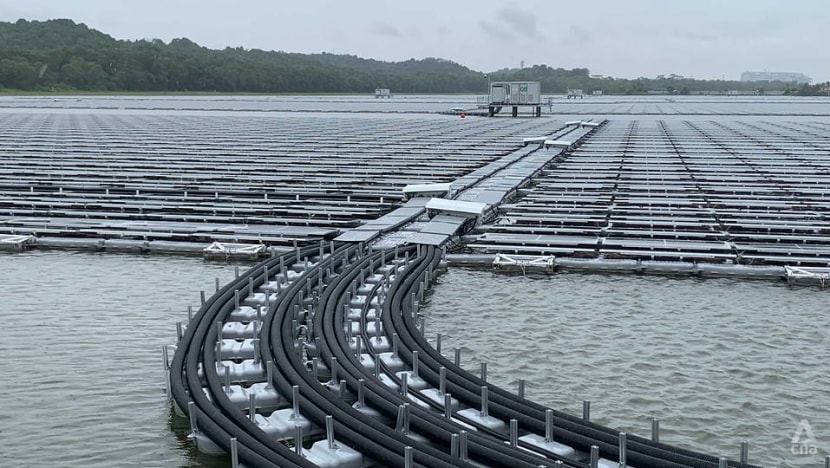Tengeh Reservoir floating solar farm officially opens, 'big step' towards environmental sustainability, says PM Lee
SINGAPORE: A 60 megawatt-peak (MWp) floating solar photovoltaic (PV) system on Tengeh Reservoir was officially opened on Wednesday (Jul 14), with Prime Minister Lee Hsien Loong hailing the project as “one big step forward towards environmental sustainability”.
Spanning 45 hectares - the equivalent of about 45 football fields - the Sembcorp Tengeh Floating Solar Farm contains 122,000 solar panels, which are durable enough to last 25 years.
It is also one of the world’s largest inland floating solar PV systems, said national water agency PUB and Sembcorp Industries in a joint press release.
“The commencement of the solar farm’s operations marks a significant step towards enduring energy sustainability in water treatment, making Singapore one of the few countries in the world to have a 100 per cent green waterworks system while contributing to the national goal of quadrupling solar energy deployment by 2025,” they said in the release.
The launch ceremony was officiated by Prime Minister Lee Hsien Loong. Minister for Sustainability and the Environment Grace Fu was also in attendance.
In his speech, Mr Lee noted that it was "important" for Singapore to keep finding ways to shift away from fossil fuels in meeting its energy needs.
"Innovations such as floating solar farms will help us overcome our physical constraints," he added.
" I hope this project will give our solar and renewable energy industry a boost, and pave the way for more such facilities to be built here and in the region. This will take us one big step forward towards environmental sustainability, as we transition into a low-carbon world."

This is equivalent to powering about 16,000 four-room HDB flats and reducing carbon emissions by about 32 kilotonnes annually, the same as taking 7,000 cars off the roads.
“With this floating solar power plant, which we believe to be one of the largest in the world, PUB takes a big step towards enduring energy sustainability in water treatment,” said PUB chief executive Ng Joo Hee.
“Solar energy is plentiful, clean and green, and is key to reducing PUB’s and also Singapore’s carbon footprint.”
Group president and Sembcorp Industries CEO Wong Kim Yin described the solar farm as the “crown jewel” in the company’s portfolio.
“As the leading homegrown renewable energy player, Sembcorp has over 3,300 megawatts of renewable energy assets around the world,” he said. “We are committed, and have the track record and competencies, to support the Singapore Green Plan.”
READ: Construction begins on Tengeh Reservoir floating solar farm, touted as one of world’s largest
A testbed was launched by PUB and EDB at the reservoir in 2016, before construction of the floating solar PV system - which occupies about one-third of the reservoir’s total area - began in August 2020.
"We came up with the idea of building a floating solar farm a decade ago. We were looking for ways to harness solar energy at scale because we do have year-round bright sunlight for solar power ... Unlike wind or hydro power, which are not reliable nor even available here," said Mr Lee.
"As the cost of solar cells came down, solar power became increasingly viable and attractive to us, so we made use of whatever available space we could find to install solar panels. We put them on building rooftops, we put them on vacant state properties. But we still lacked large-scale plots of land to scale up our solar power deployment.
Hence the idea of a floating solar farm was attractive, because it allowed us to make full use of the large surface area of reservoirs, while giving them a dual use."
And the success of the testbed - which performed up to 15 per cent better than a conventional rooftop solar power system, due to the cooler reservoir environment - provided the "confidence" to develop the farm.
"That makes Singapore one of the few countries in the world to have a fully green waterworks system producing clean water with 100 per cent clean energy, which is another remarkable achievement in our 'water story'," added Mr Lee.
READ: As the buying and selling of solar energy becomes reality, Singapore could gain further ground on solar target
An environmental impact study, which included biodiversity surveys, water quality monitoring and modelling, along with consultations with nature groups was carried out on the site between 2015 to 2018.
Results from PUB’s testbed deployed at Tengeh Reservoir in 2016 showed no observable change in water quality nor significant impact on surrounding wildlife, said PUB and Sembcorp.
“Referencing the study, the Sembcorp Tengeh Floating Solar Farm was carefully designed to minimise impact on the reservoir’s water quality, flora and fauna,” said both parties.
“Sufficient gaps between solar panels were incorporated to improve the airflow and allow sufficient sunlight to reach aquatic life. Additional aerators were also put in place to maintain oxygen levels in the reservoir.”
Floats deployed are made using high-density polyethylene (HDPE), a certified food-grade material that is recyclable, UV-resistant and corrosion resistant.
“In addition to having a comprehensive environmental management and mitigation plan, PUB and Sembcorp will continue to monitor the reservoir closely, and take necessary measures to maintain biodiversity and water quality,” said the press release.
Other floating solar PV projects in the pipeline include ones at Lower Seletar Reservoir and Bedok Reservoir. They are scheduled to be completed this year.
Environmental studies are also ongoing for a 100MWp project at Kranji Reservoir as well as a 6.7MWp project at Upper Peirce Reservoir.












